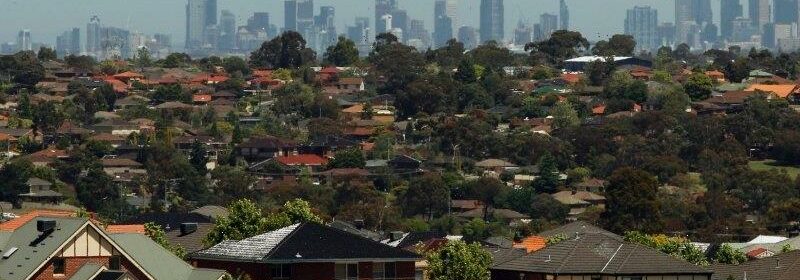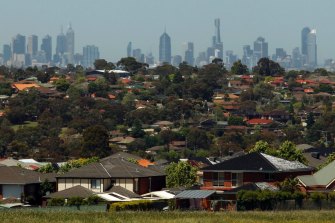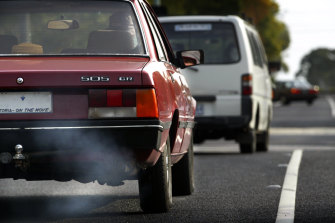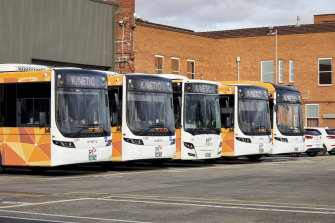Electric buses across the west every 10 minutes – it’s not a dream

Greenhouse gas emissions from transport are growing faster than any other sector of the economy – it is time to finally put the brakes on.
Despite all the clamour for greater incentives for us to drive electric cars, the surest way to meet our climate targets is to find ways for us to drive less. Offering alternatives to driving is also essential for many living in Melbourne’s car-dependent suburbs, where a second or third car is an increasing burden for households squeezed by higher interest rates and fuel prices.
Melbourne’s car dependent suburbs need alternative modes of transport.Credit:Paul Rovere
The quickest and easiest way to address both rising transport emissions and living costs is to re-invent Melbourne’s broken bus system for the 21st century.
Our recently completed and externally reviewed research at the Melbourne Centre for Cities, shows how we can within only a few years, move to clean electric buses operating on a fast, frequent, connected network that gets us where we want across Melbourne’s suburbs.
The Victorian government’s recently released Zero Emissions Vehicle Roadmap is moving in the right direction with subsidies for zero emissions vehicles (ZEV), new charging infrastructure, and a ZEV bus trial. But, the growing public appetite for climate action and rapid increases in the cost of living mean that we can and must be more ambitious. So far, there are firm commitments from the Victorian government for only 341 new electric buses to be in service by 2030. This is less than 20 per cent of Melbourne’s current route-bus fleet.
Our work with industry insiders shows how we can do better.
The government’s zero emissions plan includes subsidies for zero emissions cars and a plan for zero emissions buses.Credit:Rebecca Hallas
We know that electrification changes just about every aspect of bus operations from depot layouts to maintenance techniques and the way power is delivered and paid for. We will need strong government leadership to manage costs and risks across multiple industries and strict rules about what happens to the diesel fleet, with clear timelines for them to be off the road, not just sold on for other uses.
Battery-electric buses are already operating in many places overseas . The government could make an informed call now on technical specifications for vehicles and charging infrastructure, and use its buying power to establish the necessary supply chains and performance regulations. This is possible because the state ultimately pays for the capital and operating costs of Melbourne’s buses.
But there is a catch. Melbourne’s buses run under 28 separate contracts with fourteen private operators – some big multinationals, others small family businesses delivering only a few services. Many operators have, over decades, developed a sense of ownership of “their” routes and resisted efforts to simplify the system. This model cannot accommodate the transition to electric buses. So, the expiry of most of the smaller contracts in mid-2025 is an important deadline for finding new ways for government and contractors to collaboratively manage the transition.
Kinetic is trialling electric bus routes in Melbourne.Credit:Louis Trerise
This transition to cleaner buses is only the first step. It won’t help the climate or ease suburban transport woes if we run clean buses on today’s convoluted routes and unreliable timetables which only very few Melburnians use. We need more Melburnians using buses.
Fortunately, there is a proven approach to bus service design, articulated by University of Melbourne researcher Paul Mees in the 1990s, that can help us get the most value from a new electric bus fleet. Paul’s work showed how some cities, by exploiting what he called the ‘network effect’, attract drivers onto public transport even at residential densities comparable to suburban Melbourne. They do this by operating fast and frequent services connected in a grid that makes it easy to travel to many destinations. Effectively, the convenience that travellers find so appealing in London and Paris can be reproduced in the suburbs using electric buses.
This approach underpins Victoria’s 2021 Bus Plan. This plan is a great first step, but it is a more of a mud map than the detailed blueprint we need for the next term of state government.
In Better Buses for Melbourne’s West, we use the Remix transit planning tool to show how a modern bus network would give communities in Melbourne’s west an alternative to driving.
We started by drawing a grid network on key arterial roads that would run at a 10-minute frequency all day (including weekends) with an average speed of 25 km/h.
We were surprised to find that a new network could be delivered using existing operational budgets for buses in the west, plus a modest top-up to keep pace with population growth.
Capital costs, for this first stage, are also low, with upgrades only needed at bus stops and at key intersections to give buses priority.
Once it’s up and running, we could super-charge the network, making it even faster and cheaper to run by investing in internationally proven techniques to isolate buses from other road traffic.
Our modelling also showed that, on average, more than three times more people could reach shops, services, and opportunities for social interaction at their local centre within 30 minutes on a weekday morning. For Hoppers Crossing, the increase is more than tenfold! And, these new bus services would be within an 800-metre walk of most households in the west. This would be easily accessible for most people and, if linked to affordable on-demand services, would leave no one behind.
Our research shows we can be optimistic about finding alternatives to driving in the suburbs. The task now is for the government to refine a new network through careful planning and community consultation and for all of us to build political support to make a world-class system of clean electric buses a reality in Melbourne before 2030.
Most Viewed in National
From our partners
Source: Read Full Article


